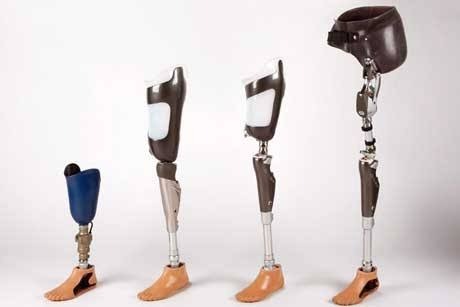
An artificial limb is a prosthesis worn by a person who has either undergone a limb amputation or has been born with an absent or deficient limb.
The artificial parts that are most commonly thought of as prosthesis are those that replace lost arms and legs. The aim of the prosthesis is to replace the form and/or function of the absent limb. Prosthetic components have unique design requirements depending where they are located within the prosthesis and what they are required to do. This chapter describes how prosthetic fabrication techniques have changed over time and discusses some of the opportunities and challenges associated with using additive manufacture within the industry.
The type of artificial limb used is determined largely by the extent of an amputation or loss and location of the missing extremity. Artificial limbs may be needed for a variety of reasons, including disease, accidents, and congenital defects.

Recently, there have been significant advancements in artificial limbs. New plastics and other materials, such as carbon fiber, have allowed artificial limbs to be stronger and lighter, limiting the amount of extra energy necessary to operate the limb. With advances in modern technology, cosmesis, the creation of life-like limbs made from silicone or PVC, has been made possible. Such prosthetics, such as artificial hands, can now be made to mimic the appearance of real hands, complete with freckles, veins, hair, fingerprints, and even tattoos. Cosmesis are attached to the body in any number of ways, using an adhesive, suction, form-fitting, stretchable skin, or a skin sleeve.
There are Four Main Types of Artificial Limbs
These include the transtibial, transfemoral, transradial, and transhumeral prostheses. The type of prosthesis depends on what part of the limb is missing.
A transradial prosthesis is an artificial limb that replaces an arm missing below the elbow. Two main types of prosthetics are available. Cable operated limbs work by attaching a harness and cable around the opposite shoulder of the damaged arm. The other form of prosthetics available are myoelectric arms. These work by sensing, via electrodes, when the muscles in the upper arm moves, causing an artificial hand to open or close.
Transhumeral Prosthesis
A transhumeral prosthesis is an artificial limb that replaces an arm missing above the elbow. Transhumeral amputees experience some of the same problems as transfemoral amputees, due to the similar complexities associated with the movement of the elbow. This makes mimicking the correct motion with an artificial limb very difficult.
Transtibial Prosthesis
A transtibial prosthesis is an artificial limb that replaces a leg missing below the knee. Transtibial amputees can usually regain normal movement more readily than someone with a transfemoral amputation, due in large part to retaining the knee, which allows for easier movement.
Transfemoral Prosthesis
A transfemoral prosthesis is an artificial limb that replaces a leg missing above the knee. Transfemoral amputees can have a very difficult time regaining normal movement. In general, a transfemoral amputee must use approximately 80% more energy to walk than a person with two whole legs. This is due to the complexities in movement associated with the knee. In newer and more improved designs, after employing hydraulics, carbon fiber, mechanical linkages, motors, computer microprocessors, and innovative combinations of these technologies to give more control to the user.
Other less prevalent lower extremity cases include:
- Symes: This is an ankle disarticulation while preserving the heel pad.
- Knee disarticulations: This usually refers to an amputation through the knee, dis- articulating the femur from the tibia.
- Knee disarticulations: This usually refers to an amputation through the knee, dis-articulating the femur from the tibia.
There are several areas of technology that have advanced significantly recently and are showing considerable potential. Robotic limbs and direct bone attachment are two new technologies that have made tremendous gains recently.
Quick Facts Regarding Prosthetics
Prosthetics have been mentioned throughout history. The earliest recorded mention is the warrior queen Vishpala in the Rigveda. The Egyptians were early pioneers of the idea, as shown by the wooden toe found on a body from the New Kingdom. Bronze Roman crowns have also been found, but their use could have been more aesthetic than medical. With advances in medical science, a few experimental prostheses have been integrated with body tissues, including the nervous system. These highly advanced devices can respond to commands from the central nervous system, more closely approximating normal movement and utility than older prostheses.


Good day sir/ma ,am omolabake by name my 10yrs boy got into an accident and his leg was amputate,above the knee.how can I get 2 ur address,and how much is the price of the artificial this is my WhatsApp no 08137063751 thanks
Thank you Omolabake. We will get in touch with you soon.